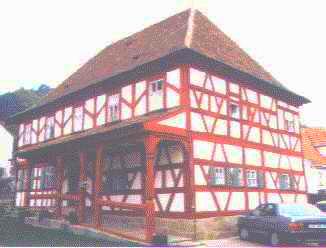Lecture reader / handout
(updated) for:
- Technical building equipment in the architectural monument
Conference of the adviser for monument preservation of 'The German Castles Association for the Preservation of Historic Buildings' (Deutsche Burgenvereinigung DBV e.V:).
Wuerzburg, fortress Marienberg, 31.01. - 01.02.2004
- Study day for preservation and restoration
Care of monuments and monument use
The architectural monument and its equipment in the area of conflict between preservation and use
Training further center of the FH Erfurt, 25.06.2004
- Room envelope and technology in the architectural monument
Annual convention of the skilled work circle of castles and gardens in Germany
Bayreuth, Neues Schloss, 02. - 04.04.2006
Konrad Fischer
Conserving buildings and interiors by keeping them at a moderate temperature
Bases, planning, execution and operation by the example of the garden castle Veitshoechheim
The castle Veitshoechheim
had been built 1680 to 1682 as a summer resort for the prince bishop Peter
Philipp von Dernbach of Wuerzburg of architect Heinrich Zimmer, perhaps after plans of Antonio
Petrini. Under prince bishop Karl Philipp of Greiffenclau the castle had been extended with living rooms / apartments
by architect Balthasar Neumann 1749 to 1753 adding transverse buildings at the narrow sides.
The complete building is approx. 55 m long and in
average approx. 12 m broad and contains two floors with a storey height of approx. 5 meter. The attic is an empty room without use.
The fronts with external walls are approx. 70 cm thick and consist of rendered / plastered
natural stone masonry and large single pane windows, predominantly four wings with glazing bars.
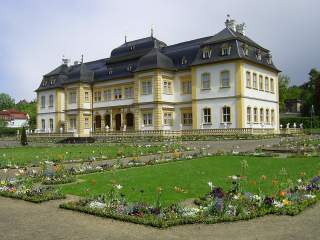
Garden castle Veitshoechheim, the front from west
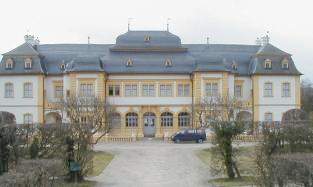
Front from east
From 1752 to 1753 Antonio Bossi created the rich stucco works at the ceilings and walls in the upper floor.
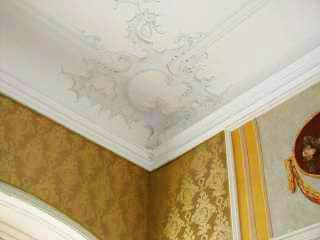
Stucco ornament in the OG
In 1810 some rooms got furnished for the habsburgian Grand Duke Ferdinand of Toskana. The
high-quality of room equipment and the castle's importance had been improved with rare wall papers.
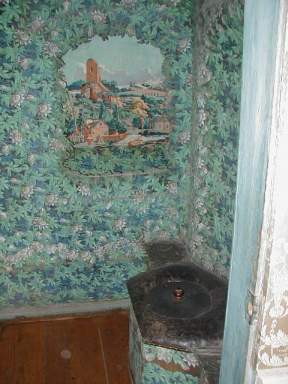
Wall paper in the duke's toilet, ...
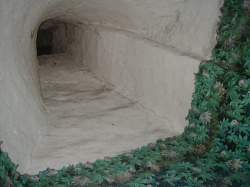
... above the toilet seat a ventilation shaft.
The castle is used only seasonally and in the winter closed for visitors.
The climatic measurements before the project start proofed, that weather and use-conditioned moistening and
wide range variations of the seasonally temperature change brought huge amounts of condensation of damp warm air
in the cooler walls especially in spring time. The harmful hygrothermal fluctuations caused substantial damage to the
solid building construction (dry rot, corrosion) and the high-quality mobile and wall-fixed equipment (black mold /
mildew /fungal growth on the organic wall papers, deterioration of water absorbing wooden, textile and organically
coated surfaces, losing binder in the detached or disintegrated historic paint layers, mobilizing of salts
in mineralic parts of the wall like render and natural stone. In the stucco parts and all external walls cracks and
hollow aereas had been caused by moisture and temperatur stress). The long termed comparative measurement of the external and internal
air temperatures and indoor climate proofed f.e. in March 2001 higher outside temperatures up to 13 K. In January I measured with my IR-Thermometer
0 °C on the internal wall surfaces of the first floor. So condensate storage into the undercooled internal areas and
temperature stress in all parts of the building construction had been unavoidable. The long term degradation of the
building envelope components is correlated with the outdoor climate and contradicting all efforts of maintenance
and building repair.
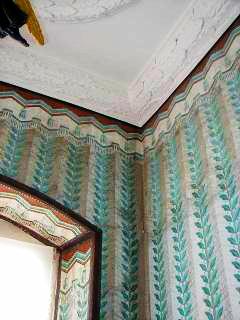
Wall paper with formation of black mold / mildew
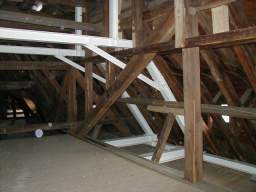
Some years before the responsible building office of the state repaired the damages of the condensate-moistured
rotten timberwork (dry rot) in the attic. Additional static support by steel girder systems was inserted.
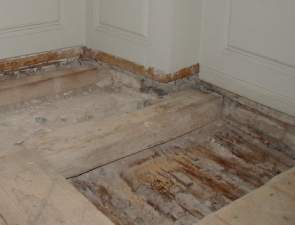
After uncovering of the timber floor boards and the parquet flooring in the
upper floor also here large condensate-caused wood damages became apparent.
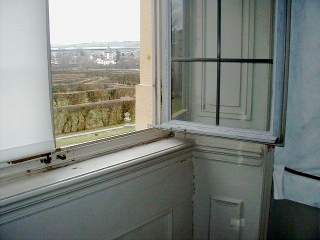
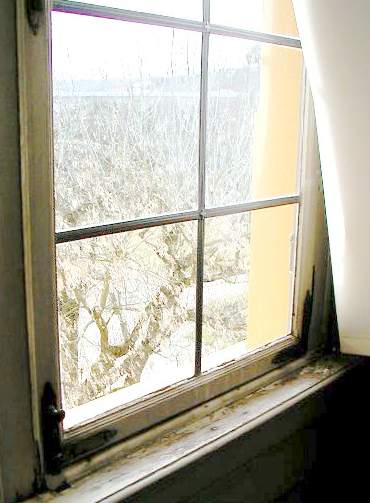
During cold outside temperatures the surplus room air dampness could condens at the
single windows. This decreased larger moisture penetration damage in the other building parts
in critical climatic situations. Infrared radiant heat (wavelength >
2.7 µm) cannot penetrate glass panes just like ultra-violet UV light (< 0.3 µm).
Over 99% of the heat transport through the outer envelope depends on radiant
heat and not on so called 'heat conductivity' and the R-value (in a room with 20 m² and 2.50 m height the 50 m³
heating air with 62,5 kg weight and adequate amount of heating energy stands in the opposite to an infrared IR
thermal radiation of the to 20 °C warmed up surfaces of inner walls, ceiling and
floor with over 10 tons weight and their huge sum of stored heating energy!). The single windows
reduce the humidity content of the room air by target condensation and
improved gap permeability in the heating season also. This decreases
also the power requirement for the heating up of air. In addition
double glass is diminishing the energy gain from free solar radiation. For all
these reasons single windows are - contrary to usual acceptance - pure energy
savings constructions. They were repaired without any additional glazing.
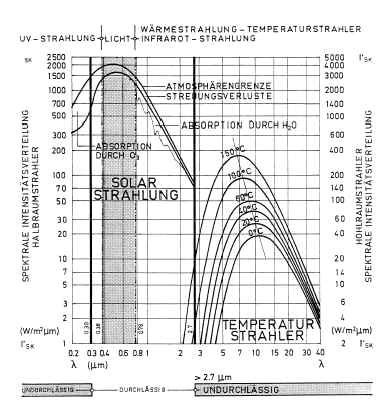
Permeability of window glass pane for wavelength spectra: UV and IR wavelenghts can not permeate the glass pane, the range of
visible light can! (diagram: Professor Dr.-Ing. habil. Claus Meier, Nueremberg)
The governmental building office Wuerzburg and the Bavarian castle administration decided in view of the
climatically caused dampness damage to conservational counter measures: In connection with the restoration of the room
envelopes / shells and use-conditioned changes I got charged with engineering for the installation of a climate
stabilizing and temperating room envelope heating system.
Main objective for the heating strategy thereby has been the prevention of further condensing into the
internal building surfaces, furniture and other exhibited equipment. To reduce the room climate change
stresses on the surfaces only slowly sliding temperature and dampness changes
are allowed. This conservational goals are fulfilled by a programmable control of the interior
temperature 6 K (Kelvin) over the outside temperature in a temperature range from at least 6 °C to upper
delimitation on 20 °C. This economically driven heating with starting
from 5 Kelvin temperature difference and disconnection at 7 Kelvin is sufficient in order
to work against internal condensate admission. The corrosive moistening and temperature stress on
the damageable and sensitive content of the historic building are substantially diminished thereby.
The often postulated so-called 'ideal climate' for indoor situation in museum rooms with relatve humidity of 45-55 %,
an arbitrary definition without scientifically sufficient reason, was for our planning irrelevant and remained
unconsidered. Many more substantially for the reduction of the damp- and
temperature-dependent material corrosion are: the climatic fluctuations and changes nearby the exposed equipment and the building
parts and the actual surface temperature of the objects. These are are relvant topics for the dampness admission and
absorption and must be controlled. A low air humidity can cause severe condensate damages by contacting an under-temperated material surface.
The situation at the material surface is the protection object
in the sense of preservation and conservation! This dedicates the temperating radiation heating as the indispensal
safeguard-strategy and conservational treatment in contrast to usual air conditioning:
The radiant heat as electromagnetic wave within the IR range penetrates the room air at speed of light. The heat
radiation can't heat the air, but only the irradiated surfaces. The warmed surface then 'indirectly' warm up the
contacting air molecules. As analogy the rays of light illuminate only light absorbing objects by impact, but
in the air however are invisible. Thus heat-irradiated objects are always warmer and on higher temperature level,
than the air molecules nearby. The air in rooms with heat radiation is warmed up only indirectly in the contact range
with the warmed material. Therefore these room air remains always cooler than the room envelope and the inventory. Thus
the air pressure difference to outside air is diminished, likewise the ventilation heat losses and the heating energy
consumption.
Dampness from air can condense only at colder, not at warmer
surface. To that extent all air heating systems and likewise over
air heating working convectionally heating systems (convector heating,
baseboard heating) work not only as dust centrifuges, but also as humidification
mechanisms with senselessly wasteful heating energy consumption. For
museums, historically valuable equipped rooms and damp-sensitive
building constructions and inventories offers the room envelope heating based on radiant heat
unbeatable advantages. Both in conservational and in economical sense regarding the operating cost.
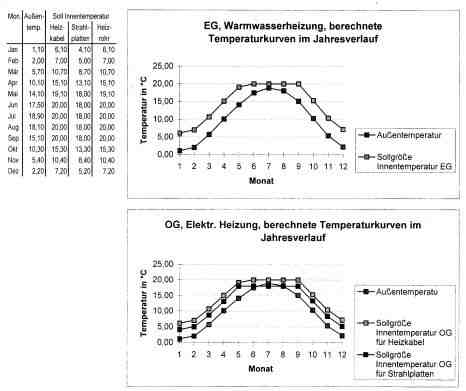
Temperature curves in first and second floor in relation to the outside temperature as control default for the wall envelope heating system
Also during the computation and planning of the heating system we calculated in accordance with the governmental building service department
quite differently, than by the standard procedure. Our heat requirement calculation regarded the
local yearly temperature curve (not the average for whole Germany) and by the arithmetic procedures
with the Reff-values of Professor Claus Meier, which considers the solar absorption and heat storage
capability of the solid building materials in relation to the local solar radiation which
can be found exactly in Veitshoechheim in the yearly process. Together with the economically advantages of the wall envelope heating
the ventilation heat losses could be reduced substantially.
The initial values of the heat conduction coefficients for the historical structures were inferred from the
technical standard quality specifications and terms of the TGL 35424/02 (a building regulation of the former German
Democratic Republik), since the new building-oriented DIN 4108 supplies no values. The alternative computation improves
the R-value of a wall on the north side of 1,14 on 0,54, at the east and west side of 1,14 on 0,20 and on the south
side of 1,14 up (minus!)-0.12 W/m²K.
Some examples of the german building research shall illustrate the correctness of our controversial point of view:
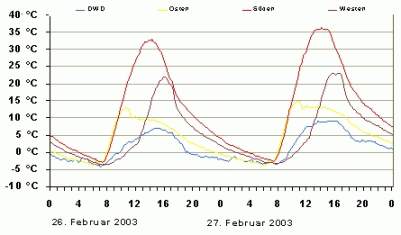
In an open land measurement the department of building research of the federal research institute for
agriculture FAL in Braunschweig showed that solid construction parts (here a 11.5 cm thick brick masonry) achieve
substantially higher temperatures, as the air temperature set during the standard heat requirement calculation (blue
curve). Thicker solid walls can store this solar energy and save it also into the night. Thus the heat requirement of
the space heating is lowered. The standard computation does not consider that.
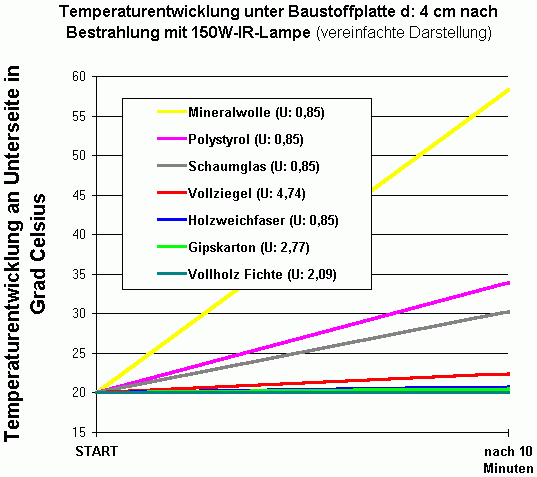
The fact that the insulating characteristics of lightweight building materials contradicts
the needs of heat protection in summer, proofed our "Lichtenfelser Experiment - Experiment of Lichtenfels". 4 cm thick building material plates
has been irradiated by a red light bulb for 10 minutes, then the temperature rising at the backside was measured.
Almost adventurously bad R-values (U-values) offer the best insulating effects! The materials from above:
Mineral Wool, Expanded Polystyrene EPS, Foamglas, Brick, Wood Fibre Board, Gypsum Card Board, Solid Pinewood. The good
temperature insulation of lightweight wooden materials depends on the evaporation of their material moisture, which transports away the heat of the radiated surface.
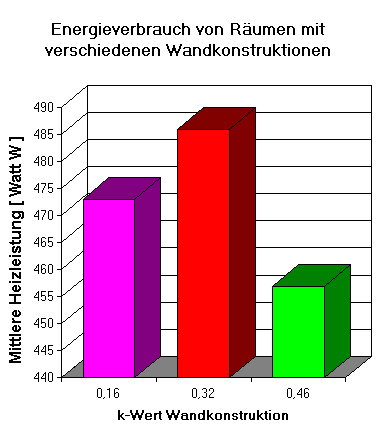
In the year 1983 the Fraunhofer Institut Holzkirchen came to know by comparative measurements of different wall constructions
(see diagram), that the smallest energy consumption requires the worst (!) k-values (=R-values). That comes probably from ability of solid
materials to diminish the consumption of heat energy by storing the solar energy during the night in the heating periods of autumn and spring.
In this case we did not take advantage of all possibilities that the real physics of radiation after Kirchhoff,
Boltzmann and Planck as well as the results of practical building research would provide us, in order to find a safer
working heating. Our planning contract has given us a big problem of responsibility, so some more safeguarding in such
a big project is understandable. The differnce regarding technical equipment coservational protection and building
investments to common planning is still huge enough.
The calculated heat requirement had been so clearly more favorably, that a small
combined heat and power unit CHP (12.5 KW) with a buffer in the vaulted celler is sufficient. The additionally peak
load is supplied by the already existing calorific value gas boilers (24 KW) of the living apartment of the facility manager.
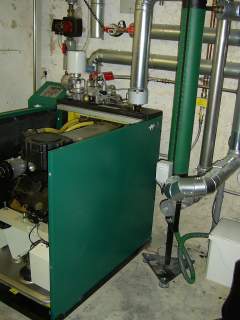
The combined heat and power unit CHP in the cellar floor produces
electrical power for the electrical wall envelope heating in the winter and the museum's need in summertime and
warm water for the heating in the ground floor.
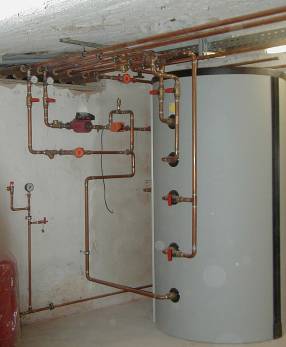
Buffer storage of the combined heat and power unit CHP in the cellar floor
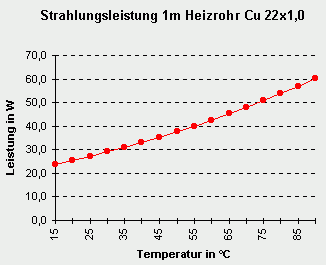 . . 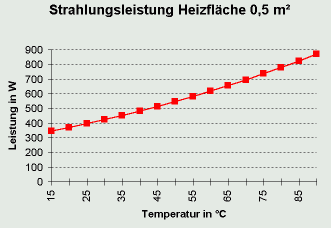
Perfectly
According to the heating and the building physics norms a 20 °C warm surface provides an output of 0
Watts (for lack of temperature difference to the even warm air). That's a wrong illusion if not a fraud and will
produce cost-expensive heating systems and senseless thermal insulation! Such warm surfaces can irradiate many more
heating power ratings because of the radiation laws. The efficiency of a room envelope heating system operating with
radiation system therefore can not be seized by standard defaults.
The warm water pipes in subordinated areas are installed openly, the base tubing cycles in the visitor range and
more important areas are installed under the wall render/plaster or as underfloor system. This was a compromise between esthetic postulations of the
responsible restorators, the interventions in the historic building and the efficiency of the heating system.
The areas with increased temperature requirements (office, guest toilets) got additional warm water-supplied radiant
panels (radiators).
All the execution planning was done by highly graded graphic details for
all technical components and interventions. This showed up during the drawing phase all the conflicts between old and
new parts as well as an exact performance specification. The expenditure used for this very detailed planning work
could diminish unplanned building interventions and material losses, cost explosions and date disasters.
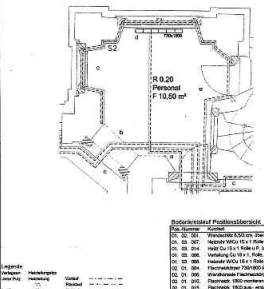
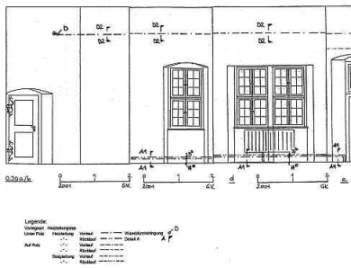
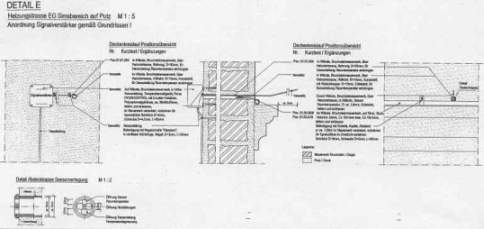
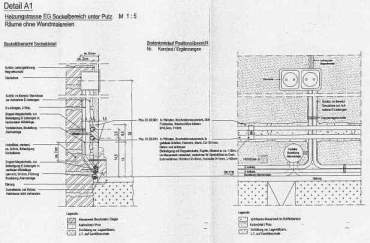
Excerpts from the design and execution plans
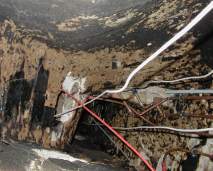
The supply lines between the floors could be led through existing chimneys and pits.
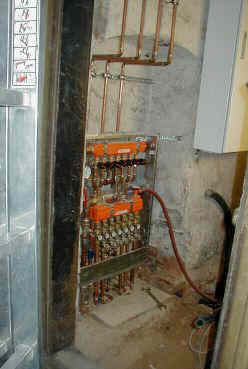
The arrangement of the warm water distribution in a subordinated room niche - careful for the building
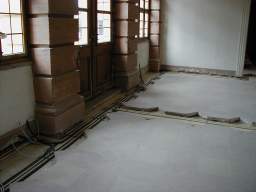
In the entrance area of the ground floor the old floor had to be taken up. So the heating pipes could be
installed in the underfloor.

In all high-quality areas the castle administration consisted on
installation under the plaster. The building interventions, the more expensive measures and the loss of efficiency
given thereby had been accepted.
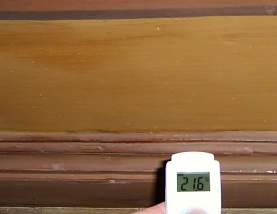
The radiation temperature of the plastered base cycle can be measured with an IR thermometer.
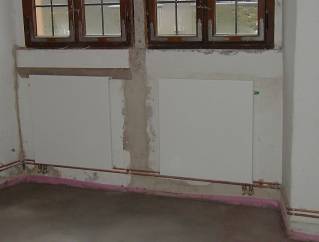
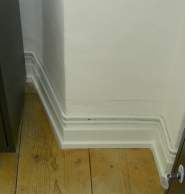
The openly installed pipes of the room envelope heating system in the
building, for increased heat requirement supplemented with radiator panels.
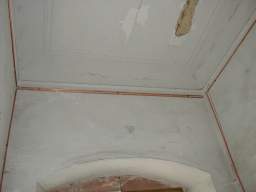
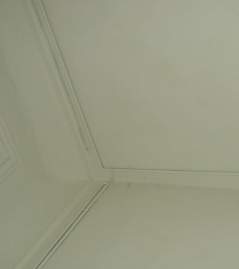
The heating pipes in the building before and after finishing the refurbishing work
As safeguard against water damage in the splendor areas of the upper floor the heating system had been carefully
installed behind the panel, under the floor and on the stucco frame by electrical heating wires of small power output (20 W/m).
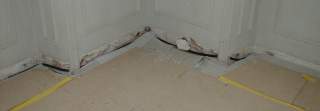
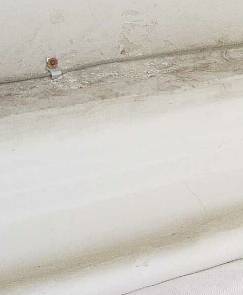
The wire route behind the panel and the nearly invisible heating wire on the stucco frame
In wintertime mobile marble slab heat emitters of different size with a power output of 400 W to 1.500 W are in use.
They are arranged in the center of the rooms and irradiate the room envelopes. The electric power of the
combined heat and power unit CHP is used also for the electrical room envelope heating. The temporary surplus is fed in
the electrical net in accordance with the power-heat-mixing law (KWK law).
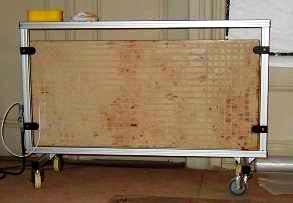 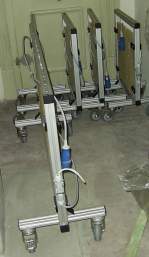
The electrical radiator panels in the initial application as building site heating and in the summer half-year in
the depot.
Because of the pilot character of the project our client required an complex controlling of the heating technique
and the monitoring of the room climate values. The energy consumption of the heating cycle components can be evaluated
individually.
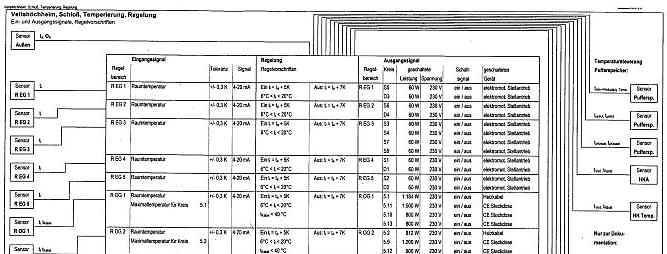
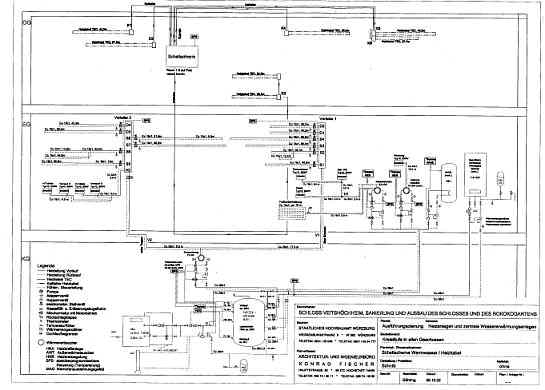
Excerpt from the control plans of the room envelope heating system
The heating energy consumption per square meter in the warm water-supplied ground floor is higher as
in the the electrically heated upper floor. We suppose as a logically result of the plastered installation, which diminishes the
radiation power likewise a shadowing board would do this for a light bulb or an umbrella against the sun light. So -
burying the heating pipes in the building construction will convert and a powerful sun to a pale gloomy moon ;-)
Annual consumption:
|
1st floor kWh/a Warm water |
2nd floor kWh/a Electricity |
1st+2nd floor kWh/a |
| Consumption 04 |
30.796 |
17.035 |
47.831 |
| Consumption 05 |
30.916 |
20.645 |
51.561 |
| Consumption 06 |
28.455 |
18.719 |
47.174 |
Referring to the temperature monitoring the minimum temperature level in the rooms had been at approx. 7 to 10 °C,
even at lowest outside temperatures. This proofs the ideal interaction between the solid building construction
and the room envelope heating technology. The additional calorific value gas boiler for load peaks had to contribute
scarcely 4per cent to consumption.
Thus the example Veitshoechheim proofs that this heating system can provide generally energy savings in castles, palaces
and other historic buildings. In many monuments are the usual - technically and economically dubious or negative -
energy saving measures such as the installation of thermal insulation on the facade or interior walls and the
replacement of historic windows against modern insulated windows already excluded due to crucial conservational
arguments. So the remaining energy-saving measures are limited on the heating system - and there they may also be
particularly successful.
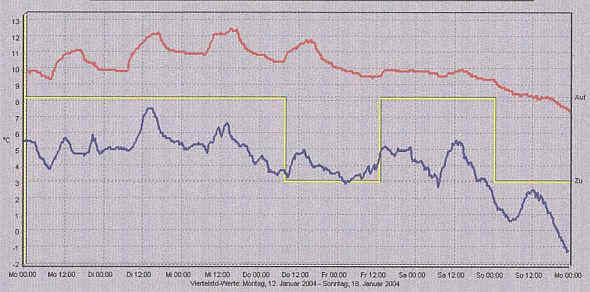
Outside temperature and interior temperature from 12th.
to 18th January 2004. The contol works perfectly and absorbs the temperature peaks. The storing of the radiant heat in the solid
construction prevents also condensate by surprisingly incoming warm air supply from the outside. The interior
temperature corresponds to the regulation goal. (Red - room temperature, managed by the heating regulation; Blue: Outside
temperature)
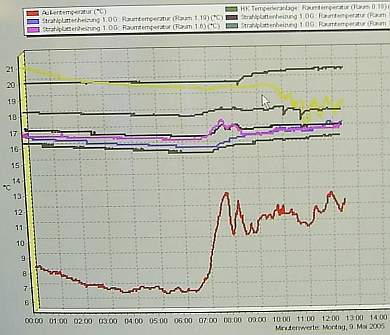
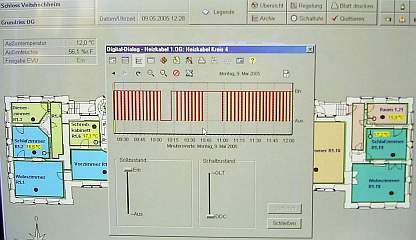
The building manager and Kastellan controls the total system during his job.
The screen curves show outside temperature and interior temperatures of
the different ranges as well as the changing peaks of the electrical room envelope heating.
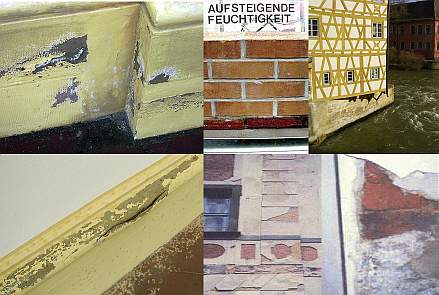
The damage arising outside at the castle base (pictures left above and down) is naturally no result of a ascending dampness / rising damp.
It is anyway impossible because of the infinite capillary resistance
between the micropore system of the masonry unit and the macropore
system of the masonry mortar. Also the long time moistured masonry
in a tub (center above) proofs this in sufficiently clarity. Therefore the
dampness horizon of the water founded historical city hall in Bamberg follows
only the range of the against flowing river water.
Typical damages caused by painting of silicate / waterglass / potassium and strengthening
are the cracking off of the over-strengthened and capillary sealed
surface crusts. This silicate coatings destroyed the original baroque render / plaster at the cistercian monastery
Waldsassen (center down). Also so-called healing plaster (Sanierputz)
(on the right down) cause no dehumidifying and desalting. They separate from the plaster base and burst because
of superelevated dampness on the back side and the driving mineral formation
between cementous bonding agent and the usual sulfate load (gypsum) in the underground.
The sometimes expressed hope, that a room envelope heating system
beside it's condensate avoidance can also fight ascending dampness / rising damp
is likewise a utopia, exactly the same as by the widespread dewatering methods by means of
horizontally masonry sawing, inox-steel sheets pressing, electro osmosis and bore hole injections.
Altogether the room envelope heating system in
the castle Veitshoechheim can proof the positive effect of the tempering radiant
heat technology in the solid construction with single windows
from the conservatorically and energetically point of view. The
construction costses: Warm water heating system with the
combined heat and power unit CHP: 70,000 EUR, electrical heating: 35,000 EUR, control: 50,000 EUR.
I thank the Bavarian castle administration and the national building
construction office Wuerzburg for the proven confidence in our
planning deviating from (nearly) all standards and the fair contract
design as well as my coworker Dipl.-Ing. Peter Goehring for his
never diminishing commitment at the time of the development and
execution of substance-careful building services.
Hochstadt am Main, 15.10.2007
The restoration report of the Bavarian castle administration, BD Peter Seibert
|
 Konrad Fischer's Homepage: Restoration, Preservation and Refurbishing of the Old Building and Patrimonial Monument
Konrad Fischer's Homepage: Restoration, Preservation and Refurbishing of the Old Building and Patrimonial Monument 
 Restoration of old buildings, conservation of monuments - Tips and Tricks +++ Mold attack - What to do? A Guide
Restoration of old buildings, conservation of monuments - Tips and Tricks +++ Mold attack - What to do? A Guide 
 Traditional Craftmanship in Modern Mortars – Does it work in practice?
Traditional Craftmanship in Modern Mortars – Does it work in practice? 
